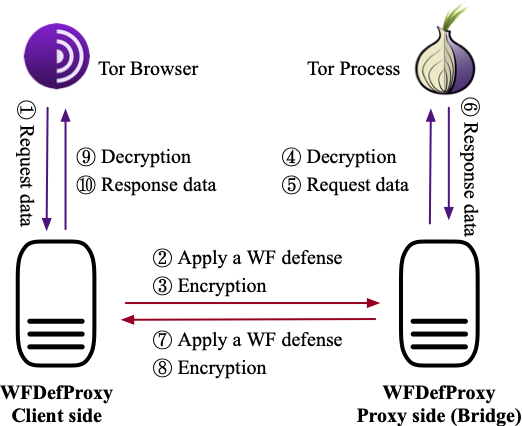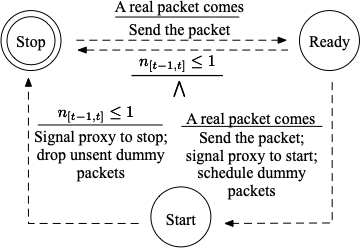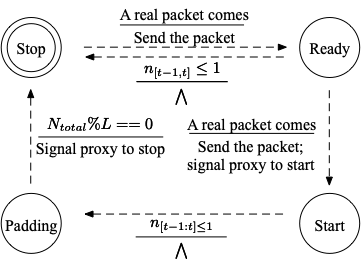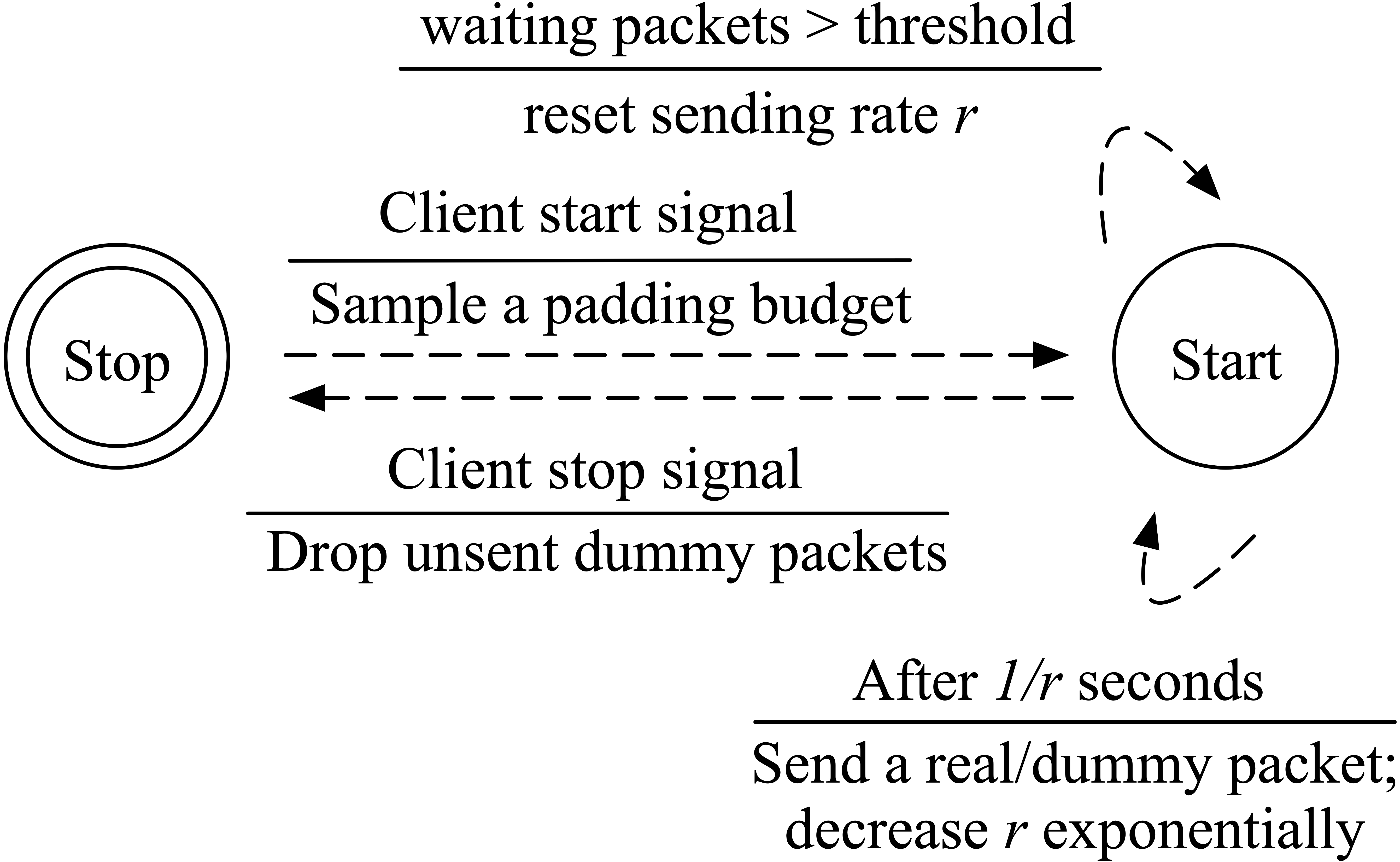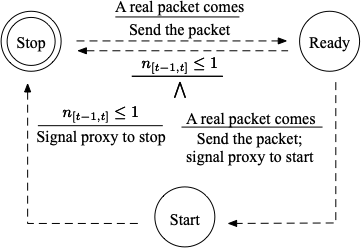WFDefProxy implements five defenses against Website Fingerprinting (WF) attack: FRONT [1], Tamaraw [2], Random-WT [3], RegulaTor [5], and Surakav [6]. It extends obfs4proxy [4], the state-of-the-art pluggable transport for Tor to circumvent censorship. It transforms the traffic between the client and the bridge according to a defense's protocol. It makes use of the cryptographic system of obfs4 to do the handshake as well as to encrypt/decrypt the packets. The workflow of WFDefProxy is shown in the figure below:
go build -o obfs4proxy/obfs4proxy ./obfs4proxy
Suppose we put the compiled binary at /Users/example/wfdef/obfs4proxy/obfs4proxy.
The torrc configuration of bridge is like:
# Feel free to adapt the path.
DataDirectory /Users/example/tor-config/log-wfgan-server
Log notice stdout
SOCKSPort 9052
AssumeReachable 1
PublishServerDescriptor 0
Exitpolicy reject *:*
ORPort auto
ExtORPort auto
Nickname "wfdef"
BridgeRelay 1
ServerTransportListenAddr wfgan 0.0.0.0:34000
ServerTransportPlugin wfgan exec /Users/example/wfdef/obfs4proxy/obfs4proxy
ServerTransportOptions wfgan tol=0.4 p=0.5
It will generate a wfgan_bridgeline.txt in /Users/example/tor-config/log-wfgan-server/pt_state,
containing a certification used for handshake as well as the configured parameters.
The client's torrc file is like:
DataDirectory /Users/example/tor-config/log-wfgan-client
Log notice stdout
SOCKSPort 9050
ControlPort 9051
UseBridges 1
Bridge wfgan 127.0.0.1:34000 cert=VdXiHCbwjXAC3+M2VZwasp+TAIbK0TuQD3MG3s024pE3brEygUOovIJo4f2oxZpBvlrNFQ tol=0.4 p=0.5
ClientTransportPlugin wfgan exec /Users/example/wfdef/obfs4proxy/obfs4proxy
You can launch Tor with command line tor -f client-torrc or replace Tor Browser's torrc file with it and launch the Tor Browser directly.
Note that if is better to also include the relay's fingerprint in Bridge option due to some bugs of Tor Browser that may cause the launch failure.
The torrc configuration of bridge is like:
# Feel free to adapt the path.
DataDirectory /Users/example/tor-config/log-front-server
Log notice stdout
SOCKSPort 9052
AssumeReachable 1
PublishServerDescriptor 0
Exitpolicy reject *:*
ORPort auto
ExtORPort auto
Nickname "wfdef"
BridgeRelay 1
ServerTransportListenAddr front 0.0.0.0:34000
ServerTransportPlugin front exec /Users/example/wfdef/obfs4proxy/obfs4proxy
ServerTransportOptions front w-min=1 w-max=13 n-client=3000 n-server=3000
It will generate a front_bridgeline.txt in /Users/example/tor-config/log-front-server/pt_state,
containing a certification used for handshake as well as the configured parameters.
The client's torrc file is like:
DataDirectory /Users/example/tor-config/log-front-client
Log notice stdout
SOCKSPort 9050
ControlPort 9051
UseBridges 1
Bridge front 127.0.0.1:34000 cert=VdXiHCbwjXAC3+M2VZwasp+TAIbK0TuQD3MG3s024pE3brEygUOovIJo4f2oxZpBvlrNFQ w-min=1.0 w-max=13.0 n-server=3000 n-client=3000
ClientTransportPlugin front exec /Users/example/wfdef/obfs4proxy/obfs4proxy
You can launch Tor with command line tor -f client-torrc or replace Tor Browser's torrc file with it and launch the Tor Browser directly.
Note that if is better to also include the relay's fingerprint in Bridge option due to some bugs of Tor Browser that may cause the launch failure.
The torrc for bridge is similar as FRONT, except that last two lines should be
ServerTransportPlugin tamaraw exec /Users/example/wfdef/obfs4proxy/obfs4proxy
ServerTransportOptions tamaraw rho-client=12 rho-server=4 nseg=200
Also, on the client side, the last two lines of the torrc file should be
Bridge tamaraw 127.0.0.1:34000 cert=VdXiHCbwjXAC3+M2VZwasp+TAIbK0TuQD3MG3s024pE3brEygUOovIJo4f2oxZpBvlrNFQ rho-client=12 rho-server=4 nseg=200
ClientTransportPlugin tamaraw exec /Users/example/wfdef/obfs4proxy/obfs4proxy
Replace Bridge with the information in tamaraw_bridgeline.txt in /Users/example/tor-config/log-tamaraw-server/pt_state.
The last two lines of torrc file for bridge:
ServerTransportPlugin regulator exec /Users/example/wfdef/obfs4proxy/obfs4proxy
ServerTransportOptions regulator r=277 d=.94 t=3.55 n=3550 u=3.95 c=1.77
Similarly, the client side
Bridge regulator 127.0.0.1:35000 cert=So0EMyNeSi8XR4BEZnHyuw5dqTaXtXg4lgW2gLBoDpSJHjKd7ZGga6UK6ilSbEcw71CRLw r=277 d=0.94 t=3.55 n=3550 u=3.95 c=1.77
ClientTransportPlugin regulator exec /Users/example/wfdef/obfs4proxy/obfs4proxy
The last two lines of torrc file for bridge:
ServerTransportPlugin randomwt exec /Users/example/wfdef/obfs4proxy/obfs4proxy
ServerTransportOptions randomwt n-client-real=4 n-server-real=45 n-client-fake=8 n-server-fake=90 p-fake=0.4
Similarly, the client side
Bridge randomwt 127.0.0.1:34000 cert=VdXiHCbwjXAC3+M2VZwasp+TAIbK0TuQD3MG3s024pE3brEygUOovIJo4f2oxZpBvlrNFQ n-client-real=4 n-server-real=45 n-client-fake=8 n-server-fake=90 p-fake=0.4
ClientTransportPlugin randomwt exec /Users/example/wfdef/obfs4proxy/obfs4proxy
We nearly keep the framework of obfs4proxy unchanged, except that we add five different transports in ./transports:
- null: do nothing but forward the packets between client and the bridge, can be used for collecting undefended datasets
- regulator: implement Surakav defense
- front: implement FRONT defense
- tamaraw: implement tamaraw defense
- regulator: implement regulator defense
- random-wt: implement random-wt defense
The key modules for each transport:
packet.go: define the packet format, the types of packets and how to parse the packetsstatefile.go: define the parameters, validity checks for the parameter values and the format of bridgeline.txt[defense].go: implement the defense, control the state transitionsstate.go: define the states of the defense
Below are the state machines for three defenses on the client side (1.FRONT 2.Tamaraw 3.RegulaTor 4.Random-WT).
The start and end of a defense is controlled by a finite state machine, where a event will trigger some actions and state transition. We define that any two packets from upstream within 1s will cause the client enter the Start state from Stop state. And we set a time window of 1s and keep observing the throughput when the defense is on. If there is no more than one packet, the defense will return to the Stop State (For Tamaraw, enter the Padding state).
On the bridge side, the start and stop of the defense is controlled by the client without such a state machine. When client turns on/off the defense, it will send a signal packet to the bridge and trigger the corresponding actions.
To implement a transport (defense), we MUST have two core functions
func (conn *someDefenseConn) ReadFrom(r io.Reader) (written int64, err error): this function intercepts data from Tor, modifies the data according to the defense and forwards to the WFDefProxy on the other side.func (conn *someDefenseConn) Read(b []byte) (n int, err error): this function receives data from the WFDefProxy on the other side, parses the defended packets and forwards to Tor.
If you want to implement a new defense on WFDefProxy, there are two main steps to follow:
- In WFDefProxy, a defense protocol is referred to as a "transport".
transports/base/base.godefines the template for a transport. You should implement all the interfaces in your defense. - Rigister your transport (defense) in
transports/transports.go(Seefunc Init() error). - Some suggestion on the implementation:
- Write a
statefile.goto deal with arguments of a defense. - Write a
packet.gowhich defines the packet format and the function of parsing the packets from the other side. - For the defense, you should define a new connection type which extends
net.Conn. Therefore, you should implementWriteandReadfunction for the transport. These two functions will automatically be called in the main programmeobfs4proxy/obfs4proxy.go(See Line 270copyLoop(a net.Conn, b net.Conn) error).
- Write a
- There are two ways to get the trace via WFDefProxy (The second is deprecated as it is not reliable and add complexity to the defense code):
- The first one is to simply add some logs about the time and bytes of the packets sent or received near the
conn.WriteorReadfunction. I have written some. The logs can be found at/Users/example/tor-config/log-[defense]-client/pt_state/obfs4proxy.log. Make sure the log function is enabled. You can check./obfs4proxy/obfs4proxy.goLine 315-316 to enable and adjust the level of logging. - The second way is to enable
traceLoggerwhich is defined in the front of[defense].go. Any outside programme can signal traceLogger to start/stop logging the packet information via gRPC communication. You should modify the following parameters in the code (provide an address and enabletraceLogger):The definition of a gRPC message can be found atgRPCAddr = "localhost:10086" traceLogEnabled = true./transports/pb/traceLog.proto:When received a message withmessage SignalMsg { bool turnOn = 1; string filePath = 2; }turnOn=true, WFDefProxy will log the packet information (timestamp, direction and size) tofilePath. When received a message withturnOn=false, WFDefProxy will stop logging.
- The first one is to simply add some logs about the time and bytes of the packets sent or received near the
- WFDefProxy can be used together with WFCrawler, the toolkit we developed for crawling and parsing traces.
Build time library dependencies are handled by the Go module automatically.
If you are on Go versions earlier than 1.16, you might need to run go get -d ./... to download all the dependencies. Note however, that modules always use
the same dependency versions, while go get -d always downloads master.
- Go 1.16.0 or later. Patches to support up to 2 prior major releases will be accepted if they are not overly intrusive and well written.
- See
go.mod,go.sumandgo list -m -u allfor build time dependencies.
[4] Yawning Angel. "obfs4 - The obfourscator"
This repository is only intended for research purpose. Codes may have bugs. We do not guarantee it secure against any attacker in the real world. Please be cautious if you want to use it in the real Tor network.
- Yawning Angel for explaining the code of obfs4proxy
